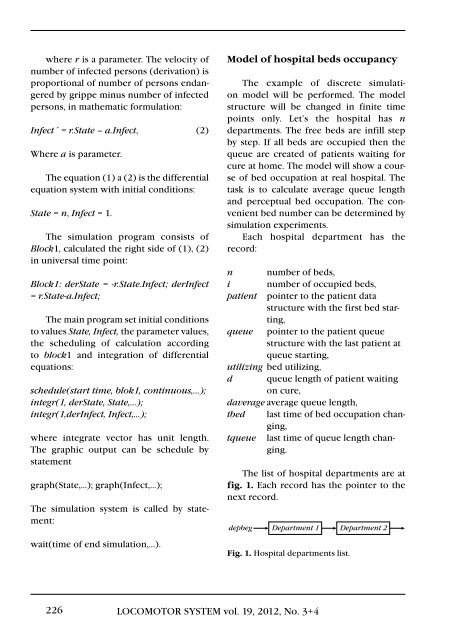3+4+Supplementum/2012 - Společnost pro pojivové tkáně
3+4+Supplementum/2012 - Společnost pro pojivové tkáně
3+4+Supplementum/2012 - Společnost pro pojivové tkáně
- TAGS
- www.pojivo.cz
You also want an ePaper? Increase the reach of your titles
YUMPU automatically turns print PDFs into web optimized ePapers that Google loves.
where r is a parameter. The velocity of<br />
number of infected persons (derivation) is<br />
<strong>pro</strong>portional of number of persons endangered<br />
by grippe minus number of infected<br />
persons, in mathematic formulation:<br />
Infect´ = r.State – a.Infect, (2)<br />
Where a is parameter.<br />
The equation (1) a (2) is the differential<br />
equation system with initial conditions:<br />
State = n, Infect = 1.<br />
The simulation <strong>pro</strong>gram consists of<br />
Block1, calculated the right side of (1), (2)<br />
in universal time point:<br />
Block1: derState = -r.State.Infect; derInfect<br />
= r.State-a.Infect;<br />
The main <strong>pro</strong>gram set initial conditions<br />
to values State, Infect, the parameter values,<br />
the scheduling of calculation according<br />
to block1 and integration of differential<br />
equations:<br />
schedule(start time, blok1, continuous,…);<br />
integr(1, derState, State,…);<br />
integr(1,derInfect, Infect,…);<br />
where integrate vector has unit length.<br />
The graphic output can be schedule by<br />
statement<br />
graph(State,…); graph(Infect,…);<br />
The simulation system is called by statement:<br />
wait(time of end simulation,…).<br />
226<br />
Model of hospital beds occupancy<br />
The example of discrete simulation<br />
model will be performed. The model<br />
structure will be changed in finite time<br />
points only. Let’s the hospital has n<br />
departments. The free beds are infill step<br />
by step. If all beds are occupied then the<br />
queue are created of patients waiting for<br />
cure at home. The model will show a course<br />
of bed occupation at real hospital. The<br />
task is to calculate average queue length<br />
and perceptual bed occupation. The convenient<br />
bed number can be determined by<br />
simulation experiments.<br />
Each hospital department has the<br />
record:<br />
n number of beds,<br />
i number of occupied beds,<br />
patient pointer to the patient data<br />
structure with the first bed starting,<br />
queue pointer to the patient queue<br />
structure with the last patient at<br />
queue starting,<br />
utilizing bed utilizing,<br />
d queue length of patient waiting<br />
on cure,<br />
daverage average queue length,<br />
tbed last time of bed occupation changing,<br />
tqueue last time of queue length changing.<br />
The list of hospital departments are at<br />
fig. 1. Each record has the pointer to the<br />
next record.<br />
depbeg Department 1 Department 2<br />
fig. 1. Hospital departments list.<br />
LOCOMOTOR SYSTEM vol. 19, <strong>2012</strong>, No. 3+4

















